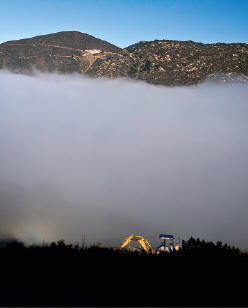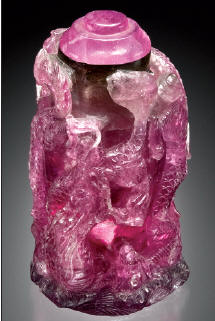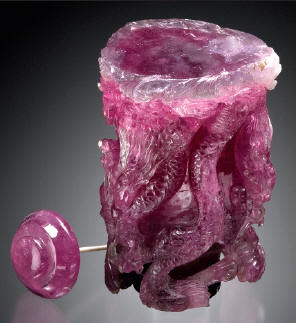INTRODUCTION
The Tourmaline Queen Mine is oneof the most famous localities among mineralcollectors. For over 100 years themine has produced hundreds of kilogramsof gem tourmaline crystals and ahuge amount of specimens. Among manypockets the “blue-cap” find made themine so famous. Some collectors believeit is the most important find ever.

Valley fog and the Tourmaline Queen Mine on Queen Mountain, as seen from the Oceanview Mine. M. Mauthner photo.

Elbaite with quartz and albite from the “six-pack” pocket found in 1984 in the Tourmaline Queen Mine, USA. 13.2 cm tall. M. and M. Swoboda specimen.
Several authors have written extensivedescriptions of history and geologyof the mine which were used to compilethis text. The most important ones arecited at the end of the article.
LOCALITYThe Tourmaline Queen Mine is locatedon a slope, close to the summit of 585 m high Tourmaline Queen or QueenMountain. It is located 2.7 km to thenorth of Pala and 72 km NNE from SanDiego, in San Diego County, SouthernCalifornia, USA. The mine is locatedwithin the territory of the Pala IndianReservation.
Apart from the Tourmaline QueenMine there are several other miningoperations, both small and large, presenton the same mountain. The best knownare the Tourmaline King Mine andthe Stewart Lithia Mine. Other hills locatedto the East are famous for othermines such as the Oceanview Mine, thePala Chief Mine and the White QueenMine.
GEOLOGY AND MINERALOGY
Like the majority of pegmatites inSouthern California, the pegmatites occurringin Tourmaline Queen Mountainare formed as veins and tabular bodiesintruded into the fractures in granite.
Over 100 year old chinese carved snuff bottle, 8.5 cm tall. Carved from a single crystal from the Tourmaline Queen Mine. W. Larson collection. Mark Mauthner photo.
Probably they were injected during the Lower Upper Cretaceous into thebatholith built by numerous plutons ofdifferent chemistry. The age of the plutonswas determined to be 143-101 Ma,which is during the Lower Cretaceous.

Map of North America showing inserts of the Pala area and the location of the Tourmaline Queen Mine.
Pegmatites occurring in the area are ofthe LCT type and are enriched in boron,which manifests in the presence of numeroustourmalines. Tourmaline Queen Mountain is built mainly of dioritic andgabbroid rocks with numerous pegmatiteveins. Several of them are gembearingbut the pegmatite accessed by the Tourmaline Queen Mine is definitelythe most important one. It is at least1000 meters long, and usually around 10meters thick. The average dip is about 30degrees and the strike N-S.
In the mine, pockets occur irregularlyin the pegmatite, and are groupedclose to each other in some areas. Inother parts of the pegmatite body thereis a complete, or almost complete, lackof them. Concentrations of lepidolite,larger sized crystals and finally the clayfilling the pockets are the indicators ofcavities, which vary in size from a fewcentimeters to over 3 m. Serious mineralogicalresearch has never been conductedfor the Tourmaline Queen Mine,therefore little is known about the microminerals.
From the collector’s point ofview only a few of the mineral speciesare important. They are briefly describedbelow.
Beryl was found in many pocketsforming gem crystals. Usually their colorvaried from almost colorless, through orangeishto pink, while the size rangedfrom a few to almost 10 cm (exceptionally).
Crystals were formed in tabularform with the dominant basal pinacoidface and very short prism typical formorganite. The majority of them alsofeatured well developed pyramid facestruncating the pinacoid. Often the pinacoidfaces were lustrous and glossy,while the other faces were frosted due topreferential etching. Some of the crystalswere highly etched.
The combinations ofcolorful tourmalines with pink berylcrystals are especially appreciated bythe collectors as they are extremely uncommonin other localities. In the TourmalineQueen Mine they were collectedonly from a few finds.
Feldspars, albite and microcline appearin the majority of the pockets. Whiteto grey and yellowish cleavelandite (var. of albite) forming spheroidal aggregateswas particularly frequent and often cooccurredwith tourmalines and beryls. Itgave a great contrast to the colorful tourmalinesincluding some of the “bluecaps”.
Mica was represented mostly by lepidolitebut muscovite was also noted.
Usually micas occurred as small crystalsbut some exceptions are known - crystalseven 7 cm long have been reported.
Lepidolite together with other mineralsformed the matrix for the gem crystals insome pockets.








 YueGongAnBei 44051102000467
YueGongAnBei 44051102000467


 |
|